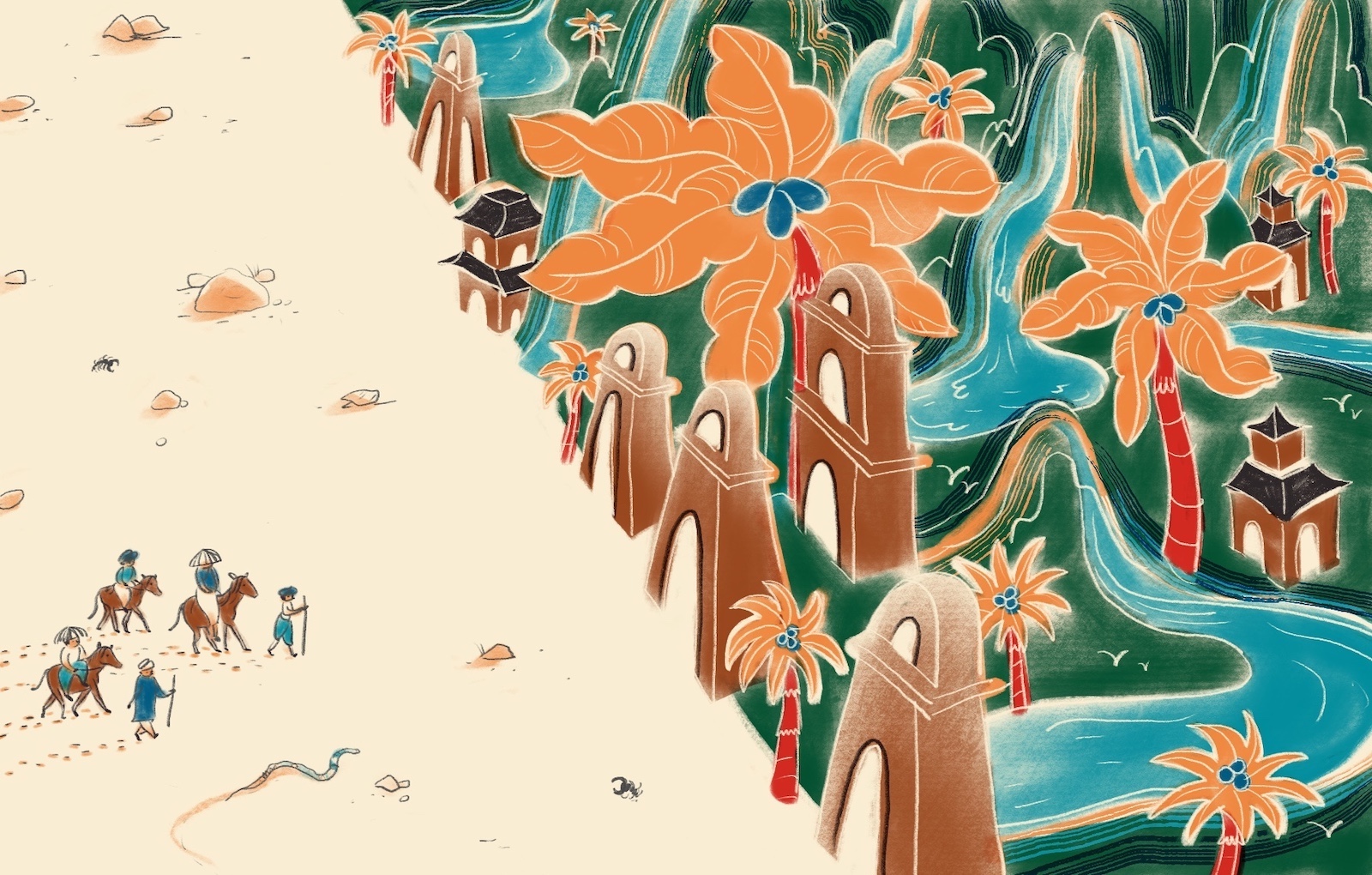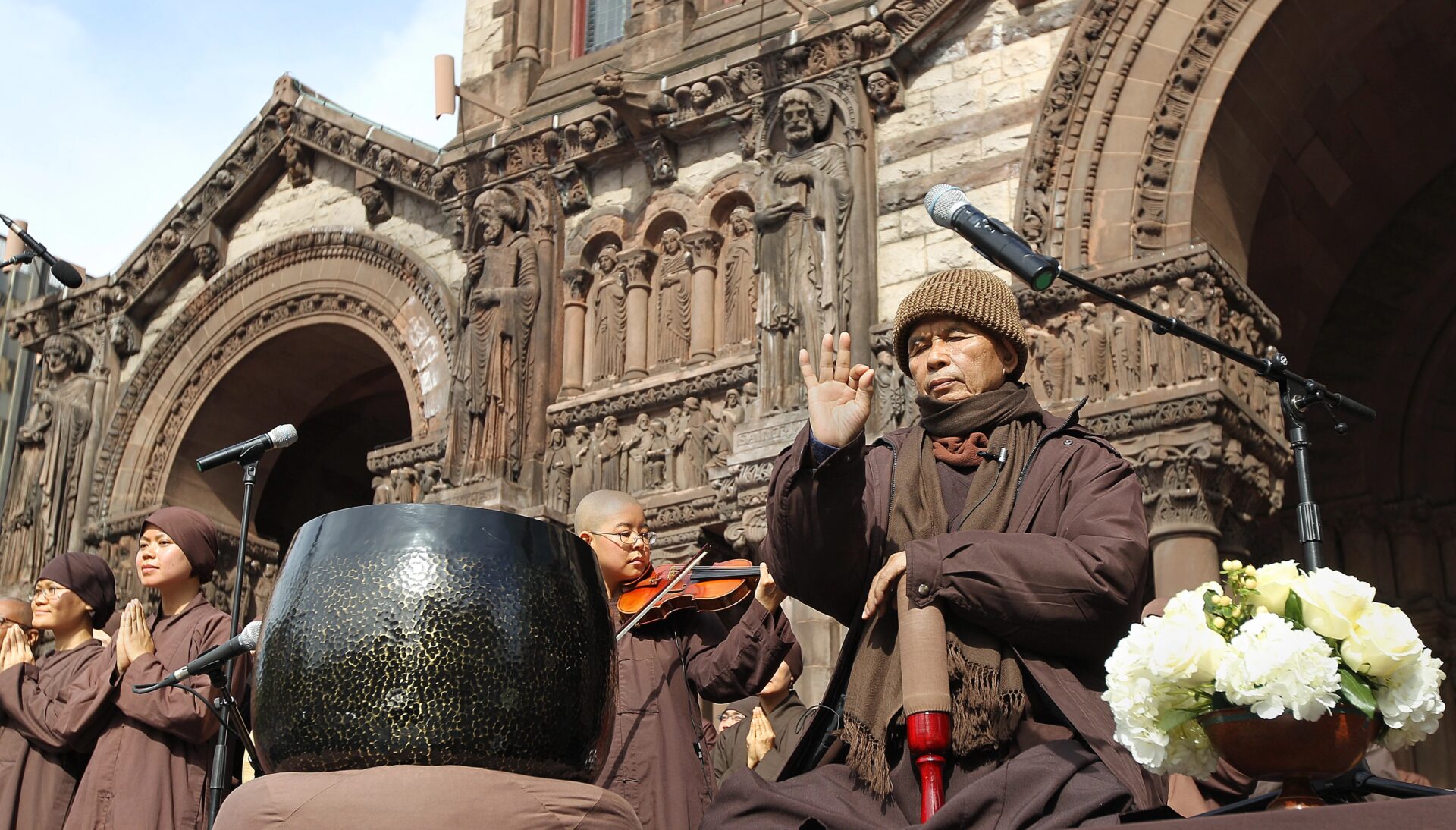Becoming Our Own Guide through the Parable of the Conjured City
In order for his followers to fully develop on their spiritual paths, the Buddha teaches an important lesson about self-perception. The post Becoming Our Own Guide through the Parable of the Conjured City appeared first on Tricycle: The Buddhist...

In the Parable of the Conjured City—in Chapter Seven of the Lotus Sutra—the Buddha shares an allegory along the Silk Road to illuminate why he has offered various teachings to people according to their needs, capacities, and understanding.
In the parable, a large group of people seeking a place of rare treasures hires a knowledgeable caravan guide to lead them through a terrifying landscape of danger to a place of fabulous treasures. Like many an epic, the road is long, exhausting, and perilous. Inevitably, the treasure hunters become weary and discouraged, doubting the guide, the journey, and even the existence of their destination. They begin to want to turn back. Understanding their angst and exhaustion, the guide uses his great supernatural powers (skillful means) to conjure a city in the middle of the wilderness where the group can rest and recuperate. Once the group is rested and restored, the guide causes the city to disappear, telling the group the city was only an illusion, made so that they could rest and that the place of treasures is nearby.
This parable uses the setting of the Silk Road as a metaphorical device that would have been well-known to people of that time through the trade, commerce, and caravansaries along the network of Eurasian trade routes.
The traditional explanation of this parable is that the Buddha was hesitant to begin his teachings with the One Vehicle, concerned people would become discouraged, thinking it was too difficult to understand. The Buddha, therefore, used his skillful means, teaching the three vehicles—shravaka, pratyekabuddha, and bodhisattva—as step-progressions along the difficult journey of awakening. As the Buddha says, just before offering the parable:
Why is this? Because the Tathagata wisdom is hard to believe and hard to understand… By the Buddha Vehicle (the One Vehicle) alone will they attain extinguishment, for there is no other vehicle, other than those expounded as skillful means in the Tathagata’s teachings… know that the Tathagata’s skillful means reach into the depths of the natures of living beings. He knows they crave and enjoy lesser teachings and that they are deeply attached to the five desires. Therefore, for their sake, he teaches nirvana.
Another parable about skillful means, the Buddha uses the repetition of this theme throughout the Lotus Sutra to reinforce the importance of skillfulness and its implication that everything is impermanent and constantly changing. Nothing lasts forever, even the dharma. The Buddha’s teachings are layers upon layers that at times can seem contradictory. If everything is empty, is anything real? If things are real, how are they empty? These contradictory ideas are beautifully reconciled in the Middle Way; both are true. Holding two seemingly contradictory ideas in one’s mind and reconciling them is the intention of koan training. A conversation between Dazu Huike, the second patriarch of Chan, and Bodhidharma, illustrates the paradoxical nature of koan in one particular succinct dialogue:
Huike said to Bodhidharma, “My mind is anxious. Please pacify it.”
Bodhidharma replied, “Bring me your mind, and I will pacify it.”
Huike said, “Although I’ve sought it, I cannot find it.”
“There,” Bodhidharma replied, “I have pacified your mind.”
While the Buddha’s teachings are dense and, at times, paradoxical, he understood more than anyone that people need a clear structure, purpose, and destination. A person needs reasons to get out of bed in the morning and carry on. In Chapter Three’s Parable of the Burning House, he offered his children toys of rare value to get them to escape the burning house. In this parable, he entices them with finding riches and treasure. Both parables share the idea of valuable rewards being used as skillful means to motivate people, liberating them from suffering. The danger to the treasure hunters is so great, the journey so hard, that the commensurate reward must be equally phenomenal.
The Buddha often taught by example. In this parable, he is a wise, knowledgeable caravan guide who conjures a city in the middle of nowhere. In this context, “to conjure” means to create or cause something to happen through Dependent Origination. One of the Buddha’s supernatural powers was his ability to create new things through his intention. Through his example, we know we can conjure our own cities as rest stops too.
While the Buddha twice exhorts the treasure hunters to be diligent in their efforts and never give up, this parable also shares a gentle reminder to practice metta, for ourselves and for others. We all need a place to rest. We all need solace and comfort. We all need to find the balance between effort and ease. The parable reminds us to be kind to ourselves. When the road feels too hard, we need to give ourselves a space to rest.
Another common theme the Parable of the Conjured City shares with others from the Lotus Sutra is that of the importance of self-perception. In Chapter Four’s Parable of the Wealthy Man and His Poor Son, we learn that we are what we believe ourselves to be. Our experiences, and our circumstances, are all shaped by our self-perception. Our poor sense of self-perception causes us to think, “There is no way I can ever become a buddha. It’s too hard.” A verse from the parable expounds on this idea, showing how the treasure hunters felt close to resignation:
‘We are tired and afraid and can go no farther. The road ahead is too long. We want to turn back now.’
Yet, the parable compassionately breaks down this long, arduous journey into attainable steps. Step by step, we advance, grow, and transform toward the destination of the fabulous treasure land.
The conjured city is a metaphor for Dependent Origination (conventional reality) and the wilderness for Emptiness (impermanence). Emptiness is no doubt an incredibly scary concept, one the Buddha taught only to advanced bodhisattvas. Emptiness can be such an overwhelming idea that people seek many ways to avoid it. Knowing this, the Buddha taught various teachings as way stations along our journey to help us make sense of things.
The parable’s treasure hunt represents our own spiritual journey. Within the Parable of the Conjured City exist many parallels to an application of a psychological development model to spiritual faith that American theologian James Fowler writes about in his book Stages of Faith: The Psychology of Human Development and the Quest for Meaning. In it, Fowler posits that people go through six identifiable stages in their spiritual growth. The first three stages are outwardly driven and characterized by rules and external authority: parents, peers, and authority figures. Fowler considers this external support necessary for a person until they can develop their own spiritual awareness. He writes:
A person in stage 3 (believes in these) values and normative images, articulates them and defends them and feels deep emotional investments in them … people resist or avoid invitations to awareness and a more conscious responsibility for their beliefs and values (instead becoming stuck) in their reliance on external authority, values, and images…
The last three stages of Fowler’s model are inwardly driven and characterized by one’s internal faith and awareness. These stages mark a substantial shift in a person’s spiritual practice where one’s faith, once supported through an external structure, becomes firmly grounded, defined, and developed within their own internal experience. Within this parable, we see this shift beautifully captured in the metaphor of a journey through the wilderness. A journey can be terrifying, agonizing, and unsettling, or what is sometimes referred to in Buddhism as the Great Doubt. A reason this shift is so frightening and difficult is that, for our spiritual growth to continue, these external support structures must be left behind before our new internal structures are fully formed. In his Tricycle Summer 2015 article “Great Faith, Great Doubt, Great Determination,” Zen master Kuon Yamada describes the three essential conditions any seeker will need as great faith, great doubt, and great determination. The Buddha uses all three conditions in this parable, as the guide advises his caravan, “You must push onward. This is only a conjured city.”
This parable also retells the four noble truths as a story. The First Noble Truth is that there is suffering in life. Our fears and anxiety are validated. Yes, the journey is long and difficult. Life is hard. We’re not crazy or broken or incapable. The Second Noble Truth is that suffering has a cause. Our self-perception shapes our experience and circumstances. The Third Noble Truth is that suffering has an end. We are encouraged knowing there is an end. We can have hope for transformation, healing, and joy. We are empowered knowing we are in control. By changing our self-perception, our experiences and circumstances will change too. And finally, the Fourth Noble Truth is that there is a road to healing, transformation, and awakening. Because other people have reached the treasure land before us, we can get there too. The Buddha tells us, “All of you, now diligently advance together with me to the place of treasures,” a nod to the Treasure of the Sangha.
What is the treasure land the travelers are seeking? While the parable itself never says, we find the answer in Chapter Seventeen of the Lotus Sutra:
…those people who…have been able to experience even a single moment of faith and understanding will attain merits beyond limit and measure.
Our practice as Buddhists is not what style of meditation, which sutra, or which teacher we revere above all else. Our practice is to experience this single moment of faith and understanding, to abide in it, and to share it. All Buddhist practices, sutras, and teachers are simply more examples of skillful means. We chose which skillful means we have an affinity for using it to guide us toward this experience of a single moment of faith and understanding. “Single,” meaning we are fully integrated, in body and in mind. “Faith and Understanding,” meaning fully liberated. “Moment,” meaning fully engaged. This experience of a single moment of faith and understanding is the greatest treasure we could ever experience.
With this emphasis on engaged living, the Parable of the Conjured City is ultimately a story about the present moment. In The Record of the Orally Transmitted Teachings, Japanese Buddhist priest and religious reformer Nichiren Daishonin says:
Each moment of life in the conjured city is a moment of life in the treasure land.
We awaken before we awaken. Every time we sit for meditation, we are evoking our own conjured city. Our sacred place of practice becomes the treasure land, where we can rest, free of the ruminations and recriminations of the past, and the worries and anxiety over the future. We have arrived home.
In his explanation of the sutra, Nichiren taught that the word “conjured” stands in for our body, and the word “city” for our mind. “Conjured,” a verb, is our speech and actions. “Mind,” a noun, is our intention. Both body and mind are characterized by impermanence and provisionality, arising through dependent origination. The core message of the Lotus Sutra found in Chapter sixteen, is that impermanence is in fact a state of eternal abiding. Nichiren says:
This is the realization that impermanence and permanence are simultaneous and inseparable, tranquil and shining in a single moment of life.
Inevitably, people who read this parable ask, “did they ever reach the treasure land?” Yes, they did. In the Lotus Sutra, the Buddha gave everyone and everything the prediction of future Buddhahood. Therefore, we can be confident this prediction applies to us as well. This is the magnificence of the Lotus Sutra, the teaching of equality, the One Vehicle. The Parable of the Conjured City then encourages us to see every moment as a wonderful moment, full of promise and joy. We learn that the journey is the destination. We learn to become our own caravan guide, using our practice to conjure our own unique cities, for rest, for solace, and for self-care. These self-created moments give us the strength, courage, and optimism to live life freely and fully.
This is our journey.
♦
Translation from: The Threefold Lotus Sutra, A Modern Translation for Contemporary Readers. Translated by Michio Shinozaki, Brook A. Ziporyn and David C. Earhart. Published by Kosei Publishing, 2019.
“Suppose there is a perilous bad road,
Remote, beset by deadly beasts,
Without either water or grass.
It is a place that people dread.
An immeasurable multitude, thousands upon thousands,
Wish to traverse this perilous road,
But crossing five hundred yojanas,
The path stretches so far and long.
At that time, they have a guide
With good memory and knowledge,
Clear in wisdom, and determined,
Who can rescue them from trouble and save them from danger.
Those people all become tired and weary
And say to the guide, ‘We are now exhausted.
Here we want to turn around and go back.’
The guide thinks,
‘Indeed, such people should be pitied.
How can they want to turn back
And miss out on such great treasures?’
Just then, a skillful means occurs to him:
‘With my transcendent powers,
I will conjure forth a great city,
Resplendent with buildings and houses,
Encircled by gardens and groves,
With streams and bathing pools,
And a series of gates and lofty pavilions,
Full of both women and men.’
As soon as he has conjured it forth,
He comforts them by saying,
‘Have no fear.
Go into this city, and you can all
Amuse yourselves as you please.’
When those people enter the city,
Their hearts are full of joy.
All of them feel relieved,
Supposing that they have been delivered.
When the guide sees they are refreshed,
He has them gather and tells them,
‘You must push onward.
This is only a conjured city.
Seeing that you were worn out
And wanted to turn back midway,
I employed the power of skillful means
To conjure forth this city temporarily.
All of you, now diligently advance
Together with me to the place of treasures.’
So it is with me,
As the leader and guide of all beings.
I see that the seekers of the Way
Become weary and discouraged on the journey
And unable to traverse the perilous road
Of delusions and cycles of birth and death.
Therefore, I employ my power of skillful means
And expound nirvana so that they rest, telling them,
‘Your suffering is extinguished.
You have done all there is to be done.’
When I know they have reached nirvana
And have all become arhats,
I have them all gather together
And expound for them the true teaching.
Although buddhas use the power of skillful means
To make distinctions and say there are three vehicles,
There is only the One Buddha Vehicle.
The other two are expounded only as a place of rest.
What I am about to tell you is true.
The place you have reached is not extinguishment.
In order to attain the comprehensive wisdom of the Buddha,
You must exert great diligence.
Until you embody the virtues of a buddha,
Such as comprehensive wisdom and the ten powers,
And are endowed with the thirty-two marks,
You have not attained real extinguishment.
The buddhas, who are leaders and guides,
Expound nirvana to give living beings rest.
Seeing that living beings are refreshed,
They lead them into the Buddha wisdom.”

 MikeTyes
MikeTyes 
































